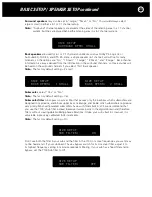
SURROUND MODES
For example, modes that generate surround channel effects from stereo sources cannot be
selected if the source is actually playing a program with discrete digital 5.1 surround channels.
When you select surround modes, those not available for your currently selected input simply
won’t show up as options. If you switch to an input that your currently selected mode won’t work
with, the 7100 will automatically select an appropriate mode (usually, Stereo for stereo sources
and Direct for surround sources).
Note:
The names of some modes are abbreviated on the 7100 front-panel display but are spelled
out on the on-screen display.
•
Mono:
Downmixes (blends) all channels of the current input signal to mono fed through the
center speaker. If you have no center speaker, and have indicated this in “Speaker setup”
(page 26), the blended mono signal will be directed to the stereo L and R outputs. (If you
prefer to hear mono through the L and R speakers, go to the “Speaker setup” menu and,
from the “Size” submenu, change “Center speaker” to “None”; don’t forget, however, to
change it back when you resume normal listening.)
•
Stereo:
Plays all sources in stereo, through the front left and right channels. When surround-
encoded sources are played in stereo mode, the contents of the surround, rear, and center
channels are reproduced in the stereo output signal.
•
Direct:
Automatically decodes and reproduces digital audio signals in their own “native”
format, whether they be 7.1 channel, 5.1 channel, stereo, or mono. Direct means these
signals are passed directly without any mode-alterations.
•
Stereo96:
A “pure audio” mode for analog input signals that raises the sampling rate of the
A/D converters from 48 kHz to 96 kHz for greater resolution of musical detail.
•
Dolby Pro Logic IIx:
This extends two channel or 5.1 channel source material to the center
channel, surround channels and back channel speakers in a 7.1 channel system. Pro Logic
IIx produces a spacious, enveloping effect. It is designed for use with stereo analog or digital
signals and for films and other two-channel material with Dolby Surround encoding. With a
single back channel speaker it is known as 6.1 channel, and with two back channel speakers
it is known as 7.1 channel. There are two types of Pro Logic IIx: Pro Logic IIx Movie and Pro
Logic IIx Music. These are our recommended surround modes if you have a 6.1 or 7.1 channel
system, and we encourage you to rediscover how exciting and alive your older recordings will
sound. Detailed information about Dolby Pro Logic IIx may be found on pages 62 – 64.
•
Dolby Pro Logic IIx Movie:
This version of Pro Logic IIx is optimized for movies and
computer games. By feeding the surround and back channel speakers different signals it
produces a more spacious, enveloping effect.
•
Dolby Pro Logic IIx Music:
This version of Pro Logic IIx is optimized for music listening; it is
designed to produce very natural-sounding surround ambience from stereo sources such as
CDs. It has three adjustments not found in Pro Logic II Movie: Center Width, which adjusts
the apparent width of the center-channel signal; Panorama, which wraps the sound of the
front left and right speakers around the listening area, and Dimension, which moves the
surround field toward the back or front of the room. These adjustments are made through the
Dolby/DTS setup page of the Audio Setup menu (see pages 47 – 48). Pro Logic IIx operates
with the adjustments you make for Pro Logic II.
•
Dolby Pro Logic II:
This extends two channel source material to the center channel and
surround channels in a 5.1 channel system without back channel speakers. There two types
of Pro Logic II, Pro Logic II Movie and Pro Logic II Music. These are our recommended
surround modes if you have a 5.1 channel system.
Note:
PLII is available only with two-channel sources; you cannot select PLII when a 5.1 (3/2.1)
digital source is playing.
•
Dolby Pro Logic II Movie:
This version of Pro Logic II is optimized for movies and electronic
games. It is designed for use with stereo analog or digital signals as well as for films and other
two-channel material with Dolby Surround encoding. Available only with two-channel sources.
30
















































